| Listing 1 - 10 of 18 | << page >> |
Sort by
|
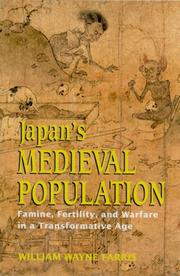
ISBN: 0824829735 9780824829735 Year: 2006 Publisher: Honolulu University of Hawaii Press
Abstract | Keywords | Export | Availability | Bookmark
 Loading...
Loading...Choose an application
- Reference Manager
- EndNote
- RefWorks (Direct export to RefWorks)
Japan --- Japon --- Social conditions --- Population --- History. --- History --- Conditions sociales --- Histoire --- J4000.40 --- J3340 --- Japan: Social history, history of civilization -- Kamakura period, Yoshino (1185-1392) and Chūsei in general (1185-1600) --- Japan: History -- Chūsei (1185-1600), Kamakura, Muromachi and Momoyama periods --- Nihon --- Nippon --- Iapōnia --- Zhāpān --- I︠A︡ponii︠a︡ --- Yapan --- Japão --- Japam --- Mư̄ang Yīpun --- Prathēt Yīpun --- Yīpun --- Jih-pen --- Riben --- Government of Japan --- 日本 --- 日本国 --- Nipponkoku --- Nippon-koku --- Nihonkoku --- Nihon-koku --- State of Japan --- Япония --- Japani --- اليابان --- al-Yābān --- يابان --- Yābān --- Japonsko --- Giappone --- Japonia --- Japonya --- Jepun --- Yapon --- Yapon Ulus --- I︠A︡pon --- Япон --- I︠A︡pon Uls --- Япон Улс
Book
ISBN: 9780824833794 9780824833251 0824833791 Year: 2009 Publisher: Honolulu University of Hawaii press
Abstract | Keywords | Export | Availability | Bookmark
 Loading...
Loading...Choose an application
- Reference Manager
- EndNote
- RefWorks (Direct export to RefWorks)
Japan to 1600 surveys Japanese historical development from the first evidence of human habitation in the archipelago to the consolidation of political power under the Tokugawa shogunate at the beginning of the seventeenth century. The book focuses on continuity and change in social and economic structures, although it does not ignore the political and cultural. Most chapters begin with an outline of political developments, and cultural phenomena--particularly religious beliefs--are also taken into account. --From publisher's description.
J4300.10 --- J4000.10 --- Japan --- Japan: Economy and industry -- history -- Kodai, prehistoric and ancient, premodern --- Japan: Social history, history of civilization -- Kodai, prehistoric and ancient, premodern --- Social conditions --- -Economic conditions --- -Wirtschaft. --- Économie --- conditions sociales --- Japan. --- Economic conditions --- -J4300.10 --- Wirtschaft. --- Conditions sociales
Book
ISBN: 0472128000 1929280491 0472901966 9780472128006 9780472901968 Year: 2009 Publisher: Ann Arbor, Michigan : University of Michigan Press,
Abstract | Keywords | Export | Availability | Bookmark
 Loading...
Loading...Choose an application
- Reference Manager
- EndNote
- RefWorks (Direct export to RefWorks)
For centuries, scholars have wondered what daily life was like for the common people of Japan, especially for long bygone eras such as the ancient age (700–1150). Using the discipline of historical demography, William Wayne Farris shows that for most of this era, Japan’s overall population hardly grew at all, hovering around six million for almost five hundred years. The reasons for the stable population were complex. Most importantly, Japan was caught up in an East Asian pandemic that killed both aristocrat and commoner in countless numbers every generation. These epidemics of smallpox, measles, mumps, and dysentery decimated the adult population, resulting in wide-ranging social and economic turmoil. Famine recurred about once every three years, leaving large proportions of the populace malnourished or dead. Ecological degradation of central Japan led to an increased incidence of drought and soil erosion. And war led soldiers to murder innocent bystanders in droves. Under these harsh conditions, agriculture suffered from high rates of field abandonment and poor technological development. Both farming and industry shifted increasingly to labor-saving technologies. With workers at a premium, wages rose. Traders shifted from the use of money to barter. Cities disappeared. The family was an amorphous entity, with women holding high status in a labr-short economy. Broken families and an appallingly high rate of infant mortality were also part of kinship patterns. The average family lived in a cold, drafty dwelling susceptible to fire, wore clothing made of scratchy hemp, consumed meals just barely adequate in the best of times, and suffered from a lack of sanitary conditions that increased the likelihood of disease outbreak. While life was harsh for almost all people from 700 to 1150, these experiences represented investments in human capital that would bear fruit during the medieval epoch (1150–1600).
Japan --- Social conditions --- Population --- History. --- al-Yābān --- Giappone --- Government of Japan --- Iapōnia --- I︠A︡ponii︠a︡ --- Japam --- Japani --- Japão --- Japon --- Japonia --- Japonsko --- Japonya --- Jih-pen --- Mư̄ang Yīpun --- Nihon --- Nihon-koku --- Nihonkoku --- Nippon --- Nippon-koku --- Nipponkoku --- Prathēt Yīpun --- Riben --- State of Japan --- Yābān --- Yapan --- Yīpun --- Zhāpān --- Япония --- اليابان --- يابان --- 日本 --- 日本国 --- History --- Population. --- Jepun --- Yapon --- Yapon Ulus --- I︠A︡pon --- Япон --- I︠A︡pon Uls --- Япон Улс
Book
ISBN: 0824882628 Year: 2019 Publisher: [s.l.] : University of Hawai'i Press,
Abstract | Keywords | Export | Availability | Bookmark
 Loading...
Loading...Choose an application
- Reference Manager
- EndNote
- RefWorks (Direct export to RefWorks)
A Bowl for a Coin is the first book in any language to describe and analyze the history of all Japanese teas. To understand the triumph of the tea plant in Japan, Wayne Farris begins with its cultivation and goes on to describe the myriad ways in which the herb was processed into a palatable beverage. Along the way, he traces the shift in tea's status from exotic gift item from China to its complete nativization in Edo (1603-1868) art and literature and its eventual place on the table of every Japanese household. Farris maintains that tea farming exemplifies the increasing sophistication of Japanese agriculture after 1350, resulting in significant exports of Japanese tea to Euro-American markets, and securing Japan a place among the world's industrialized nations. By 1800, tea had become a central commodity in the formation of a burgeoning consumer society.
History / Asia / Japan --- History --- Annals --- Auxiliary sciences of history
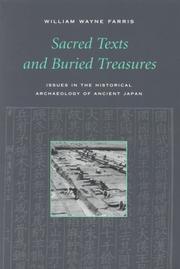
ISBN: 0824820304 Year: 1998 Publisher: Honolulu (Hawaii) : University of Hawaii press,
Abstract | Keywords | Export | Availability | Bookmark
 Loading...
Loading...Choose an application
- Reference Manager
- EndNote
- RefWorks (Direct export to RefWorks)
Inscription, Japanese. --- Wooden tablets --- History. --- Japan --- Japan --- Korea --- Japan --- Japan --- History --- Relations --- Relations --- Capital and capitol --- History. --- Antiquities.
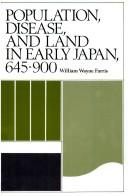
ISBN: 9780674690059 0674690052 Year: 1995 Publisher: Cambridge Council on East Asian Studies, Harvard University, and the Harvard Yenching Institute
Abstract | Keywords | Export | Availability | Bookmark
 Loading...
Loading...Choose an application
- Reference Manager
- EndNote
- RefWorks (Direct export to RefWorks)
Economic history --- Epidemics --- Land use --- History --- Japan --- Population --- History.
Book
ISBN: 082484159X 1441671153 Year: 2006 Publisher: Honolulu : University of Hawaii Press,
Abstract | Keywords | Export | Availability | Bookmark
 Loading...
Loading...Choose an application
- Reference Manager
- EndNote
- RefWorks (Direct export to RefWorks)
This volume charts a course through never-before-surveyed historical territory: Japan's medieval population, a topic so challenging that neither Japanese nor foreign scholars have investigated it in a comprehensive way. And yet, demography is an invaluable approach to the past because it provides a way-often the only way-to study the mass of people who did not belong to the political or religious elite. By synthesizing a vast cache of primary and secondary sources, William Wayne Farris constructs an important analysis of Japan's population from 1150 to 1600 and considers social and economic developments that were life and death issues for ordinary Japanese. Impressive in his grasp of detail and the scope of his inquiry, Farris makes the argument that, although this age initially witnessed the continuation of a centuries-old demographic stasis, a far-reaching transformation began around 1280 and eventually gained momentum until it swept through the Japanese archipelago. Between 1280 and 1600, Japan's population approximately trebled, growing from 6 million to 17 million. Crucial to the demographic breakthrough was the resolution of two central problems facing both the rulers and the ruled. The first was how to supply a burgeoning population with sufficient food; the second, how to keep the peace.Japan's Medieval Population will be required reading for specialists in pre-modern Japanese history, who will appreciate it not only for its thought-provoking arguments, but also for its methodology and use of sources.
Japan --- Social conditions --- Population --- History. --- History
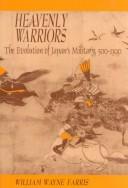
ISBN: 9781684172979 9780674387041 Year: 1996 Publisher: Boston : Leiden; Boston : Harvard University Asia Center BRILL
Abstract | Keywords | Export | Availability | Bookmark
 Loading...
Loading...Choose an application
- Reference Manager
- EndNote
- RefWorks (Direct export to RefWorks)
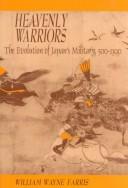
ISBN: 0674387031 067438704X Year: 1995 Publisher: Cambridge Harvard university. Council on East Asian studies
Abstract | Keywords | Export | Availability | Bookmark
 Loading...
Loading...Choose an application
- Reference Manager
- EndNote
- RefWorks (Direct export to RefWorks)
Japan --- History, Military --- History
Book
ISBN: 0824864220 0585332460 Year: 1998 Publisher: Honolulu : University of Hawaii Press,
Abstract | Keywords | Export | Availability | Bookmark
 Loading...
Loading...Choose an application
- Reference Manager
- EndNote
- RefWorks (Direct export to RefWorks)
The Japanese have long sought inspiration and legitimacy from the written record of their ancient past. The shaping of bygone eras to contemporary agendas began at least by the early eighth century, when the first court histories, namely the Kojiki and the Nihon shoki, were compiled.Since the late nineteenth century, historians have extensively mined these texts and other written evidence and by the late 1970s had nearly exhausted their meager sources. Fortunately for all those interested in uncovering the origins of Japanese civilization, archaeologists have been hard at work. Today, thanks to this postwar "archaeology boom," Japan historians have never been closer to recreating the lives of prehistoric peasants, ancient princes, and medieval samurai. Sacred Texts and Buried Treasures offers substantial new insights into early Japanese history (A.D. 100-800) through an integrated discussion of historical texts and archaeological artifacts. It contends that the rich archaeological discoveries of the past few decades permit scholars to develop far more satisfactory interpretations of ancient Japan than was possible when they were heavily dependent on written sources.
Inscriptions, Japanese --- Wooden tablets --- History --- Japan --- Korea --- Relations --- Capital and capitol --- History. --- Antiquities.
| Listing 1 - 10 of 18 | << page >> |
Sort by
|

 Search
Search Feedback
Feedback About UniCat
About UniCat  Help
Help News
News